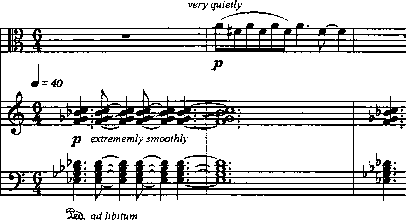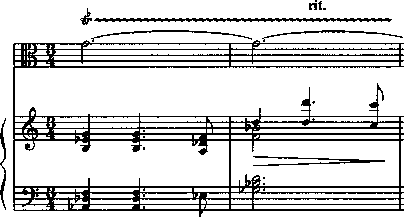129
Example 3.19: Viola Sonata, Second mvt., mm. 1-2

The static texture, along with the motives of alternating thirds and rising octaves, is
sustained throughout the first part of the movement, punctuated only once in the viola
line in m. 7. Here, a little flourish of a tritone followed by a series of thirds foreshadows
the slightly more animated motion that occurs in the middle section of the movement.
The first short hint of a meter occurs simultaneously with the first change of harmony and
tempo in m. 11. A new sonority in the piano part (a D-flat Major triad in second inversion
and an E-flat augmented triad) is emphasized with a subtle but regular dotted motive,
shown in Example 3.20. This rhythm produces the first sense of “grounding” in the
movement, perhaps suggesting that the music is “drifting” towards something.
Example 3.20: Viola Sonata, Second mvt., mm. 11-12

The sonic possibilities of the pitch C are explored in the section between mm. 23
and 29 (see Example 3.21). Addressing this section in her program note, Larsen noted “I
found that I had to calm my ears down for this work, composing subtler gestures that are,
More intriguing information
1. Getting the practical teaching element right: A guide for literacy, numeracy and ESOL teacher educators2. Personal Experience: A Most Vicious and Limited Circle!? On the Role of Entrepreneurial Experience for Firm Survival
3. Picture recognition in animals and humans
4. WP 48 - Population ageing in the Netherlands: Demographic and financial arguments for a balanced approach
5. SME'S SUPPORT AND REGIONAL POLICY IN EU - THE NORTE-LITORAL PORTUGUESE EXPERIENCE
6. Influence of Mucilage Viscosity On The Globule Structure And Stability Of Certain Starch Emulsions
7. Climate change, mitigation and adaptation: the case of the Murray–Darling Basin in Australia
8. The name is absent
9. Federal Tax-Transfer Policy and Intergovernmental Pre-Commitment
10. THE WAEA -- WHICH NICHE IN THE PROFESSION?